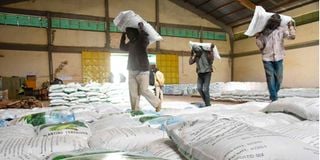Premium
Subsidies budget exceeded 12 times over

Workers carry bags of government subsidised fertiliser into a warehouse at the National Cereals and Produce Board, Eldoret depot in Uasin Gishu County.
The government has spent 12 times more money on subsidies in the first nine months of the current financial year than it had budgeted for the entire year, shedding light on the effects of a sharp rise in prices of key commodities.
Latest data from the National Treasury shows that the government has already dished out Sh34.16 billion in subsidies in the nine months to March, against a budget of Sh2.87 billion for the entire fiscal year.
The state spent Sh5.62 billion in subsidies in the first quarter of the financial year rising to Sh12.32 billion by the end of quarter two, before nearly tripling to Sh34.16 billion at the end third quarter as high fuel and fertiliser prices forced the government to avail emergency funding to cushion consumers.
This is in addition to billions of shillings allocated for sugar cane, tea and coffee farmers through the second round of the economic stimulus package to cushion farmers from low market prices.
The government last year initiated a subsidy to cushion consumers from the high cost of fuel in the wake of turmoil.
The breakout of war between Russia and Ukraine in February saw a surge in global crude oil prices, increasing local pump prices to a historic high. This forced the state to intervene by drawing into the Petroleum development Levy Fund (PDLF) to stabilise the high prices.
Last week, the Energy and Petroleum Regulatory Authority (Epra) raised prices to a historic high of Sh150.12 for a litre of petrol, Sh131 for diesel and Sh118.94 for kerosene.
To underline the importance of the subsidy programme, had the government not intervened, Kenyans would be paying Sh26.35 more on a litre of petrol, Sh43.94 more on diesel, and Sh50.32 on kerosene.
Treasury noted that the subsidy programmes are lowering inflation, underpinning the resolve by the government to persist with the subsidies in a crucial electioneering period where public sentiment on the cost of living has dominated campaign messaging.
“In March 2022, inflation decreased to 5.6 per cent from 5.9 per cent in March 2021, mainly due to easing electricity and pump prices following government interventions,” said Treasury.
The government also last month set aside Sh5.7 billion to subsidise 2.28 million 50-kg bags of fertiliser for farmers. This is meant to support the cultivation of 1.13 million acres, with farmers paying Sh2,800 per bag compared to a market price of Sh6,400.
The state has also revived the stalled subsidy scheme for cooking gas, with a Sh471 million allocation in the financial year starting July. The amount will be raised to Sh820 million in the financial year starting July 2023.
This marks a 203 per cent rise compared with the current financial year where Sh155 million had been allocated to subsidise cooking gas, whose prices hit a six-year high on the reintroduction of 16 per cent VAT last year.
Treasury Cabinet Secretary Ukur Yatani, in the draft budget released last November, included a plan to distribute 300,000 six-kilogramme gas cylinders to low-income households over the next three years.
Under the initial subsidy scheme, the beneficiaries were to pay a discounted price of Sh2,000 in three years for the burner and cylinder, with refills pegged at Sh840 ($7.64) at the time.
The revival of the LPG subsidy would be as a major relief for households pressured by the present high prices of the commodity.





